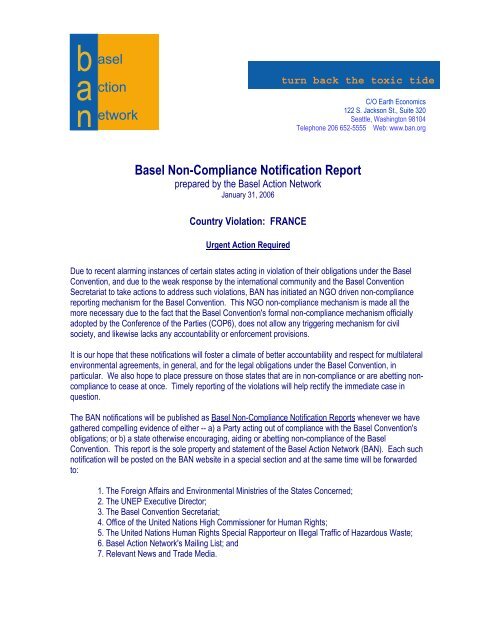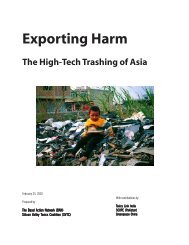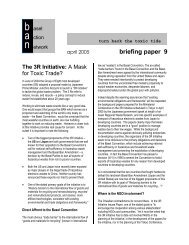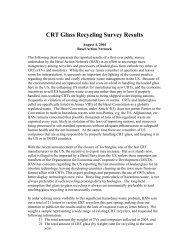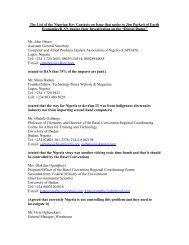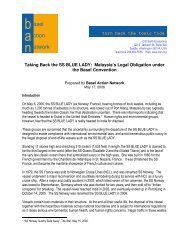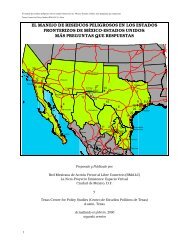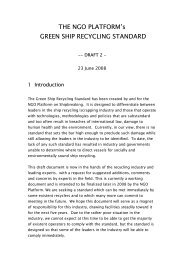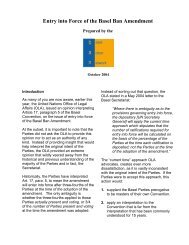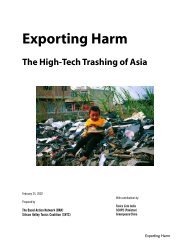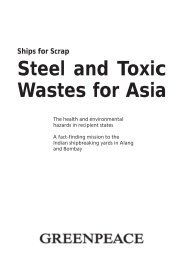asel ction etwork Basel Non-Compliance Notification Report
asel ction etwork Basel Non-Compliance Notification Report
asel ction etwork Basel Non-Compliance Notification Report
Create successful ePaper yourself
Turn your PDF publications into a flip-book with our unique Google optimized e-Paper software.
a<br />
n<br />
<strong>asel</strong><br />
<strong>ction</strong><br />
<strong>etwork</strong><br />
turn back the toxic tide<br />
C/O Earth Economics<br />
122 S. Jackson St., Suite 320<br />
Seattle, Washington 98104<br />
Telephone 206 652-5555 Web: www.ban.org<br />
B<strong>asel</strong> <strong>Non</strong>-<strong>Compliance</strong> <strong>Notification</strong> <strong>Report</strong><br />
prepared by the B<strong>asel</strong> A<strong>ction</strong> N<strong>etwork</strong><br />
January 31, 2006<br />
Country Violation: FRANCE<br />
Urgent A<strong>ction</strong> Required<br />
Due to recent alarming instances of certain states acting in violation of their obligations under the B<strong>asel</strong><br />
Convention, and due to the weak response by the international community and the B<strong>asel</strong> Convention<br />
Secretariat to take a<strong>ction</strong>s to address such violations, BAN has initiated an NGO driven non-compliance<br />
reporting mechanism for the B<strong>asel</strong> Convention. This NGO non-compliance mechanism is made all the<br />
more necessary due to the fact that the B<strong>asel</strong> Convention's formal non-compliance mechanism officially<br />
adopted by the Conference of the Parties (COP6), does not allow any triggering mechanism for civil<br />
society, and likewise lacks any accountability or enforcement provisions.<br />
It is our hope that these notifications will foster a climate of better accountability and respect for multilateral<br />
environmental agreements, in general, and for the legal obligations under the B<strong>asel</strong> Convention, in<br />
particular. We also hope to place pressure on those states that are in non-compliance or are abetting noncompliance<br />
to cease at once. Timely reporting of the violations will help rectify the immediate case in<br />
question.<br />
The BAN notifications will be published as B<strong>asel</strong> <strong>Non</strong>-<strong>Compliance</strong> <strong>Notification</strong> <strong>Report</strong>s whenever we have<br />
gathered compelling evidence of either -- a) a Party acting out of compliance with the B<strong>asel</strong> Convention's<br />
obligations; or b) a state otherwise encouraging, aiding or abetting non-compliance of the B<strong>asel</strong><br />
Convention. This report is the sole property and statement of the B<strong>asel</strong> A<strong>ction</strong> N<strong>etwork</strong> (BAN). Each such<br />
notification will be posted on the BAN website in a special se<strong>ction</strong> and at the same time will be forwarded<br />
to:<br />
1. The Foreign Affairs and Environmental Ministries of the States Concerned;<br />
2. The UNEP Executive Director;<br />
3. The B<strong>asel</strong> Convention Secretariat;<br />
4. Office of the United Nations High Commissioner for Human Rights;<br />
5. The United Nations Human Rights Special Rapporteur on Illegal Traffic of Hazardous Waste;<br />
6. B<strong>asel</strong> A<strong>ction</strong> N<strong>etwork</strong>'s Mailing List; and<br />
7. Relevant News and Trade Media.
BASEL NON-COMPLIANCE NOTIFICATION<br />
Case Title: French Vessel “Clemenceau” Toxic Waste Export<br />
Case Number: 2006-1<br />
Violating State: France<br />
Treaty Se<strong>ction</strong>s Violated: Articles 1, 4, 6, etc.<br />
Date: January 2006<br />
Documentation:<br />
1. French Official Statement to Supreme Court Monitoring Committee of India annotated by BAN, 24<br />
January 2006; http://www.ban.org/pdfs/statement_of_french_government_on_clemenceau.pdf<br />
2. “France’s Export of Decommissioned Aircraft Carrier Clemenceau to India in Violation of<br />
International, and National Law”, prepared by BAN, 12 January 2006.<br />
http://www.ban.org/pdfs/ban_clemenceau_summary_of_violations.pdf<br />
3. “The French Deception: PCBs and the Clemenceau”, BAN, 31 January 2006<br />
http://www.ban.org/pdfs/the_french_deception.pdf<br />
Case Description: France Disposes of PCB and Asbestos Laden Vessel to India<br />
On December 31, the shell of what once was France’s mightiest vessel, the aircraft carrier Clemenceau<br />
was towed out of the port of Toulon after a French court declared that it was exempt from the B<strong>asel</strong><br />
Convention due to the fact that the ship is a “warship”. This allowed the Clemenceau to be exported from<br />
France to India in what can only be seen as a clear violation of the B<strong>asel</strong> Convention. Indeed all of the 5<br />
categories outlined in Article 9 (Illegal Traffic) of the Convention have been violated, making the export of<br />
the Clemenceau illegal traffic and a criminal act.<br />
The French a<strong>ction</strong> is shocking, for up to this point, France had joined in all of the B<strong>asel</strong> Convention<br />
decisions, including Decision VII/26 which concluded that a ship can be a waste as defined in the<br />
Convention and be a ship at the same time, and called on all Parties to fulfill their obligations under the<br />
Convention with respect to ships destined for dismantling. Further, France had ratified the B<strong>asel</strong> Ban<br />
Amendment forbidding exports of hazardous wastes to developing countries.<br />
The exact nature and quantity of the hazardous materials on board the Clemenceau is difficult to ascertain,<br />
as the French government has failed to accomplish even the basic requisite step of completing a<br />
hazardous waste inventory prior to export. In the case of asbestos while the amount remaining on board is<br />
disputed and unclear, and is currently being subject to a court ordered independent review, the French<br />
have admitted they have left as much as 45 tonnes of asbestos on board but call this amount “miniscule”.<br />
In the case of PCBs the French have been even more deceptive. They have reported to both Egypt (transit<br />
state) and India that there are no PCBs on board. And yet they have failed to test for, or quantify the solid<br />
matrix PCBs that are expected to be found throughout the vessel in paints, cables, wiring, flooring, plastics,<br />
gaskets, insulation, etc. Naval vessels commissioned before 1976 contain massive quantities of PCBs, this<br />
has been known since 1989, and has presented serious problems for the United States military. It is not<br />
possible that the French government could be ignorant of this fact. It is certain that if the French had<br />
removed any solid PCB contaminated materials they would have noted the existence of PCBs in the<br />
Clemenceau. But instead they have remained eerily mute on the subject of solid matrix PCBs. Yet<br />
assertions of “no PCBs” are not credible without testing, and likewise it is not possible to adhere to all<br />
norms of the B<strong>asel</strong>, Rotterdam or Stockholm Conventions vis-à-vis PCBs without having first done testing<br />
to quantify the presence of these dangerous compounds.<br />
2
According to US government data, a similar aircraft carrier, the former USS Oriskany (25,129 light weight<br />
tonnes, 278 meter) contained 890 tonnes of solid and liquid PCB contaminated materials onboard in<br />
concentrations above the B<strong>asel</strong> regulatory threshold of 50 parts per million. The solid PCB contaminated<br />
material that was more difficult to remove was 795 tonnes. The US study on the USS Oriskany concluded<br />
that 95% of PCB loading came from electrical cable insulation, followed by bulkhead insulation. 1<br />
Extrapolating proportionally from the lightweight tonnage of the USS Oriskany and the Clemenceau and<br />
allowing a 10% margin of error we have computed that the Clemenceau (24,772 light weight tonnes, 265<br />
meters) will contain PCB contaminated material above 50 ppm in solid matrix form in a range between 744<br />
and 823 tonnes. And this is just the PCBs; as mentioned previously, there is also the issue of asbestos.<br />
The French Government claims that altogether the ship contained no more than 160 tonnes of asbestos of<br />
which 115 tonnes have been removed. However, the head of the company that was originally retained to<br />
carry out the decontamination of the ship stated that the Clemenceau contains over 500 tonnes of<br />
asbestos, and that this amount could go up to 1,000 tonnes once dismantling begins. The fact that France<br />
is even willing to send asbestos to India is the height of hypocrisy, when the very same country went before<br />
to the World Trade Organization in 1997 to fight for its ban on the export of asbestos by Canada, and won<br />
a favorable ruling.<br />
B<strong>asel</strong> Violations:<br />
BAN has prepared a paper elaborating on the B<strong>asel</strong> Convention, international, European Union and Indian<br />
law violations of France’s illegal export, this paper entitled “France’s Export of Decommissioned Aircraft<br />
Carrier Clemenceau in Violation of International and National Law” is attached in this <strong>Notification</strong>.<br />
The violations of the B<strong>asel</strong> Convention however can be summarized as follows:<br />
First it must be understood that a lack of testing, cannot excuse France from its B<strong>asel</strong> obligations.<br />
Ignorance of the presence of PCBs is no excuse under the law. The B<strong>asel</strong> Convention requires that all<br />
waste exports be correctly characterized. The absence of pertinent data cannot be seen as: “a<br />
transboundary movement of hazardous or other wastes conforming in a material way with the documents”<br />
as required by the Convention. 2<br />
Thus when France reports that there are no PCBs in solid matrix form, unless they actually conduct tests to<br />
determine if that is indeed the case, they are not excused from the intent of the B<strong>asel</strong> Convention which<br />
requires a full characterization of waste in question prior to export.<br />
Further, any transboundary movement of hazardous wastes or other wastes that obtain consent from<br />
“States concerned through falsification, misrepresentation or fraud” is illegal traffic under the Convention. It<br />
can be considered that claiming an absence of PCBs as France has done both to Egypt and to India is in<br />
fact “misrepresentation”.<br />
As PCBs above 50ppm concentrations fall within the scope of the B<strong>asel</strong> Convention when there is intent to<br />
dispose of these materials, the export outside of the B<strong>asel</strong> regime constitutes illegal traffic under the<br />
Convention if these PCBs do in fact exist on the vessel.<br />
1. France’s claim that a ship, being a military material, is somehow not a waste is without legal merit. The<br />
B<strong>asel</strong> Convention possesses no exemption for military ships or wastes of any kind and does not<br />
recognize any form of “sovereign immunity” for military vessels. Nor is it possible for Parties to make<br />
1 “Final <strong>Report</strong>: Polychlorinated biphenyls (PCB) Source Term Estimates for ex-Oriskany (CVA 34), Dec. 7, 2004. Prepared for the Program Executive Office<br />
(Ships) and Navy Inactive Ships Program, by L. Thomas Pape, available at: http://www.epa.gov/region4/air/lead/documents/CVA34FinSrceTerm<strong>Report</strong>rev4.pdf<br />
2 B<strong>asel</strong> Convention, Article 9,1,d. Illegal Traffic,<br />
3
such a reservation in the Convention. (France has misrepresented the fact by claiming an illegal nonexistent<br />
exemption)<br />
2. The ship is clearly a waste and a ship at the same time as it is a material or object and there is clearly<br />
intent to dispose – the requisites for defining waste in the B<strong>asel</strong> Convention. As a waste containing<br />
asbestos and likely PCBs over 50ppm, the Clemenceau falls under the B<strong>asel</strong> Convention’s scope of<br />
hazardous waste. The following are the 5 listed B<strong>asel</strong> requirements found in its Article 9, the absence<br />
of which constitutes illegal traffic. France has likely failed on all counts:<br />
• Prior to export, the transboundary movement must be notified to all transit states and the<br />
importing state prior to leaving the exporting state. (France failed to do this)<br />
• Consent to import and allow transit of a B<strong>asel</strong> waste ship from the states concerned must<br />
be obtained prior to export (France failed to do this)<br />
• Getting consent from an importing or transit state through falsification, misrepresentation<br />
or fraud is illegal traffic. (France got consent from Egypt to pass the Suez Canal after<br />
sending them a communiqué stating that the ship contained no PCBs, when in fact the<br />
ship had never been tested for solid PCBs.)<br />
• Shipments of waste that do not conform in a material way with the documents (the<br />
documents refer to the fact that the waste must be fully characterized with a tool such as<br />
an inventory as required in the Convention in Article 6) (France has not tested the<br />
Clemenceau for likely contaminants such as PCBs in solid form, and thus the export does<br />
not conform with the documentation)<br />
• The export cannot result in the deliberate disposal of hazardous wastes or other wastes in<br />
contravention of the Convention. (France’s misrepresentation of the PCB problem and the<br />
capacity of India to manage this problem will result in deliberate disposal in a manner<br />
which is not environmentally sound management as required in the Convention)<br />
3. The B<strong>asel</strong> Convention requires that no transboundary movement can occur without assurances that<br />
the destination facility is engaged in environmentally sound management as defined in the Convention.<br />
These requirements are laid out in Article 4; paragraph 2 (e) and (g). In this regard it is noteworthy to<br />
understand the internationally recognized fact that the shipbreaking yards in Alang do not constitute<br />
environmentally sound management as required under the Convention.<br />
This is precisely why the B<strong>asel</strong> Convention produced Guidelines for the ESM for the full and partial<br />
dismantling of ships which specified steps by which the existing yards found in India and in other<br />
developing countries are to undertake in order to fulfill the objective of environmentally sound<br />
management. And the steps to date as delineated in the B<strong>asel</strong> Guidelines have not been<br />
accomplished in full. While it may not be politically correct to state it so bluntly, it is a well known fact<br />
that the beach shipbreaking yards of South Asia cannot be considered ESM under the Convention.<br />
The Convention defines ESM broadly as:<br />
“taking all practicable steps to ensure that hazardous wastes or other wastes are managed<br />
in a manner which will protect human health and the environment against the adverse<br />
effects which may result from such wastes.”<br />
By any environmental and occupational health accounting, it cannot be seen that the yards in<br />
Alang are taking all practical steps to ensure prote<strong>ction</strong> of human health and the environment from<br />
the PCBs likely to be onboard the Clemenceau. (France has failed to ensure environmentally<br />
sound management for PCBs in Alang)<br />
4
Recommended A<strong>ction</strong>s:<br />
As of this writing, the Clemenceau is still on course for the breaking yards in Gujarat, India. However, a<br />
small obstacle is in France’s way. On January 16, 2006 India's Supreme Court Monitoring Commission<br />
(SCMC) has disallowed the entry of the Clemenceau in Indian waters, until the SCMC issues its final<br />
recommendations before February 13, 2006.<br />
It is very unfortunate that developed nations such as France continue to take advantage of low-wage<br />
countries and export a disproportionate burden of their hazardous waste ships to these countries in<br />
contravention of international law, and environmental justice. The fact that France is perpetrating this<br />
unjust and abhorrent practice is shameful. A country that boasts of higher living, occupational and<br />
environmental standards should be part of the solution not a cause of the global problem. Based on the<br />
above we make the following recommendations for a<strong>ction</strong>:<br />
1. India must never allow France to export the Clemenceau to them without first having fully<br />
quantified by independent survey, the presence and amount of solid PCBs, asbestos and other<br />
hazardous substances on the ship. If PCBs or asbestos are found then the export is a violation of<br />
either the B<strong>asel</strong> Convention or the Rotterdam Convention. If full testing does not occur the export<br />
is likewise illegal.<br />
2. France must renounce its false claim that the ship is not a waste and must take the ship back to<br />
France at once as its export is a clear violation of Article 16 of the European Union Waste<br />
Shipment Regulation.<br />
3. France must conduct a full and impartial independent survey of all expected contaminants on<br />
board the ship as part of its constru<strong>ction</strong>, and then explore ways to decontaminate the vessel in<br />
France prior to any onward export for steel recycling.<br />
4. India must not allow itself to be bullied into accepting what is clearly an affront to international law<br />
and human rights. They have a long list of legal reasons to deny the shipment. If they fail to do<br />
so, they reveal themselves to be corrupted by an industry with a dismal track record for concern<br />
over human health and the environment or international law.<br />
5. All Parties and NGOs must speak out against this clear violation of the B<strong>asel</strong> Convention on the<br />
Part of France. Direct protests to the B<strong>asel</strong> Secretariat, and French President Jacques Chirac<br />
http://www.elysee.fr/<br />
END<br />
5


